Nothing is worse than buying your dog a new chew and watching him finish it in a flash before looking up at you with those big, sad eyes pleading for more.
And to think, you thought that chew would last him all day! Or at least a few hours…
Worse, flimsy dog chews can be dangerous, risking the ingestion of broken chunks that can cause stomach upset, blockages, and painful potty problems.
With that in mind, we’ve gathered our favorite long-lasting chews that will keep your dog chewing happily (and safely!)
Check them out with us below.
Best Long-Lasting Dog Chews: Key Takeaways
- Long-lasting dog chews help keep your dog busy for a long time while stimulating his natural chewing instincts.
- Select a safe dog chew to reduce the risk of your dog injuring his mouth, choking, or suffering from an intestinal obstruction.
- Some of the safest chews include collagen chews, fish chews, tracheas / esophaguses, and yak cheese.
The Importance of Chewing
Chewing is as natural for your four-footer as wagging his tail is.
It’s a positive, healthy energy outlet that you should encourage, (though you should put boundaries on chewing of course – no one is saying you need to sacrifice your favorite shoes).
Offering dog-friendly chews helps fulfill this instinct and prevents canine boredom that can lead to more mischievous behaviors.
Chewing is also a fun and easy way to keep your dog’s teeth and gums free of harmful buildup — in addition to regular brushing with a quality dog toothpaste.
You can also incorporate specially-formulated dental chews into your dog’s routine to keep his chompers clean.
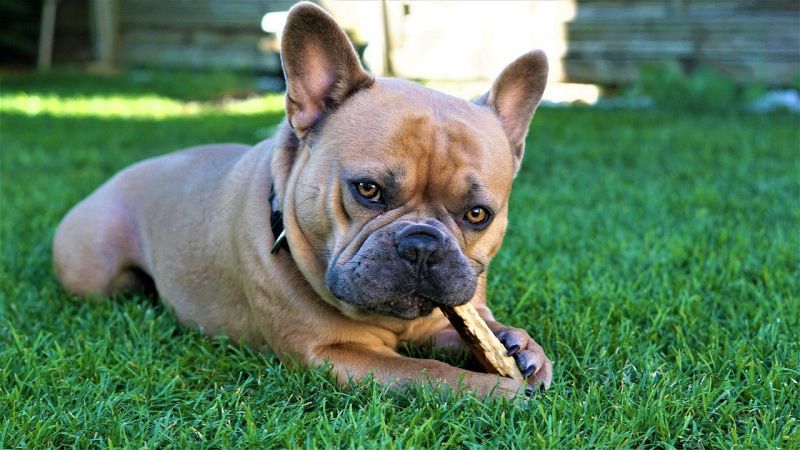
Dog Chew Safety 101: Risks Involved
Chewing is important, but so is chewing safety. Some chews are safer than others, though all dog chews have inherent risks, including:
- Choking: Anytime your pupper chomps, there’s a risk he may swallow (intentionally or accidentally) the entire chew or broken off pieces. Like CPR, learning the Heimlich for dogs is always a good idea for every pawrent. To avoid this, be sure to remove any pieces of chew that have been worn down to be less a few inches or whatever size poses a choking risk to your dog based on his size.
- Broken teeth: Too hard of a chew (or too eager of a chewer) can lead to tooth damage, including painful cracks or entire breaks. Broken teeth are not only painful for your pup, but you’ll have to spend a small fortune to fix them.
- Mouth injuries: Cuts on the tongue, gums, and lips are possible if the chew has sharpened edges or a rough surface. Remove or sand down any pointed edges that may develop from your dog’s chomping over time.
- Obstructions: If swallowed, a chew could lead to a painful, costly, and potentially life-threatening intestinal blockage.
- Stomach upset: Ingested chews can cause tummy troubles, especially if your dog has food sensitivities or if the chew is oily. Even chews that your canine can digest may cause trouble if given in excessive quantities.
- Bacterial contamination: As your dog chews and slobbers on an item, bacteria spreads across it. Over time, the chew can become a potential bacterial bomb of trouble in the home for you and your pup. Not only is odor a concern here, but so is sickness. You can prevent bacteria from growing by cleaning off your dog’s favorite chew now and then, or swapping it out for a new one if it’s been several months.
It’s important to remember that every doggo and situation is different. A dog may be fine with one treat for years and suddenly have an issue, while another pup may experience problems with nearly every chew he has.
When selecting a chew, it’s important to consider key things regarding your dog, such as:
- Chewing habits: Some dogs are more voracious of chewers than others, so you need to select a chew that suits his chewing style. If he’s overly eager to bite down hard — rather than more gentle gnawing — ultra-hard chews may not be the best idea, as you don’t want to risk tooth damage. Similarly, too soft of a chew can make it easy for your pup to bite off large pieces or create splinters, creating a choking hazard.
- Size: Always choose a chew appropriate for your dog’s build. Treats that are too large can be hard to chew, while those that are too small create an obvious risk for choking and bowel obstruction if swallowed. Your dog should never be able to fit the entire chew in his mouth.
- Health: Keep your doggo’s overall well-being in mind. If he has known allergies or dental issues, certain chews are no-gos. Similarly, a dog with a history of stomach blockages shouldn’t be trusted with a chew at all. If you’re unsure about your dog’s dental health or risks, check with your vet.
- Age: Older dogs tend to be savvier in the chewing department, whereas puppies may be more prone to swallowing things they shouldn’t and chomping too hard, risking tooth and mouth injury. Also, senior pups with failing teeth require softer chews (or none at all) if their teeth are damaged.
With dog chews, the most important steps you can take toward keeping your dog safe are:
- Monitor your dog: There are no exceptions here. Accidents happen, even if your mature chomper has chewed the same treat since he was a puppy. As with babies, choking happens in the blink of an eye.
- Know your pups limits: A more destructive chewer may tolerate hardier chews, while a casual chewer should ideally receive softer varieties.
- Test chew hardness: Do the thumbnail test on a prospective chew. If you press your nail into an item’s surface and it doesn’t leave an impression, it may be too hard for your pupper and poses a higher risk of causing tooth damage.
- Examine chew’s preparation: Not all chews are created equal. American-made products are generally preferred due to their superior safety and quality standards. Always check what processes and checks are in place during manufacturing. Some “all natural” chews aren’t so natural, either. For instance, some rawhide may contain trace amounts of toxic chemicals used in manufacturing, like formaldehyde.
- Scrutinize ingredient lists: Look for any potential allergens, as some chews are flavored with proteins like chicken or reinforced with grains, such as potato starch. Smoking and flavor coatings can also introduce additional additives that can cause stomach upset, particularly if your dog ingests a lot at once.
No chew is 100% risk-free, and you should always monitor your dog when he’s enjoying one.
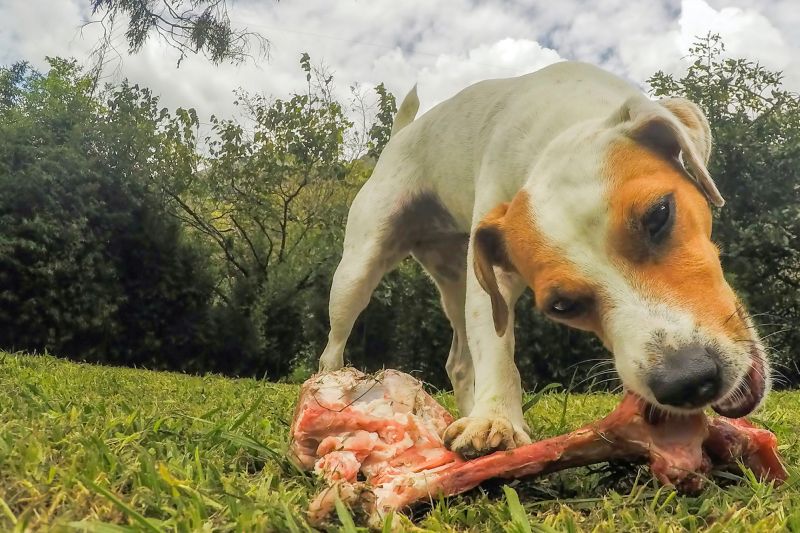
Types of Dog Chews
Many dog chews exist today, making finding the right long-lasting one for your doggo quite the feat. The most common are:
1. Antlers
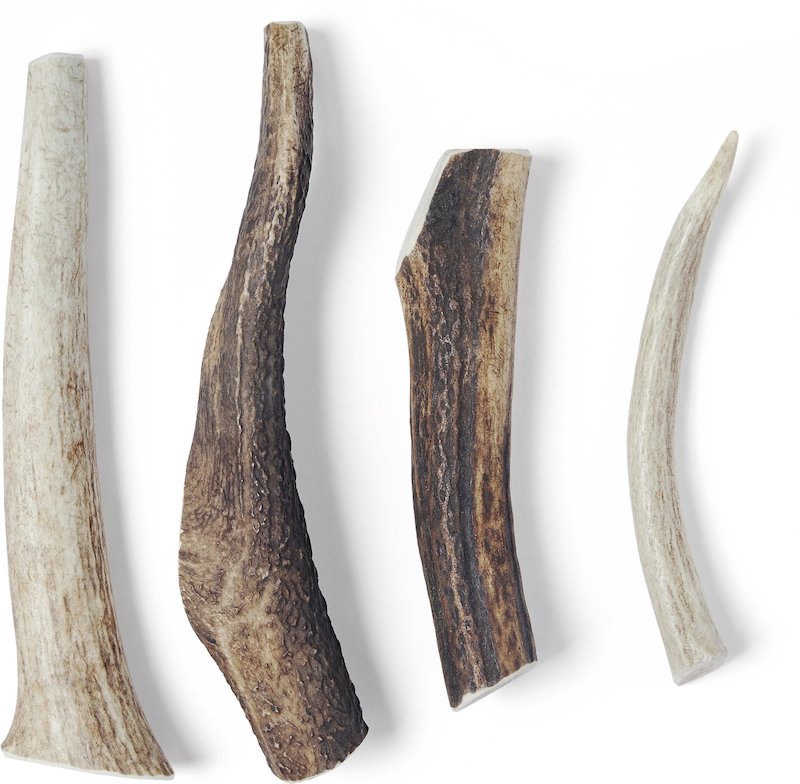
About: These harvested antlers from elk, deer, or moose are some of the closest to all-natural dog chews you can find.
They’re shed naturally by the animal yearly, limiting their overall environmental footprint.
Antlers typically don’t stain or stink, making them ideal for in-house chewing. They are on the pricier side, however.
PROS
Antlers are one of the hardest dog chews on the market and generally last a long time. This makes them ideal for aggressive chewers. They also contain pup-pleasing minerals, like calcium and phosphorus.
CONS
Because antlers are so hard, there’s a serious risk of tooth and mouth injuries. They can also splinter, leading to possible stomach or backdoor damage if swallowed. They aren’t the tastiest option either – not all dogs are a fan.
Check out our antler review article to learn more and see a few of the best options on the market.
2. Beef Knee Caps / Knuckles
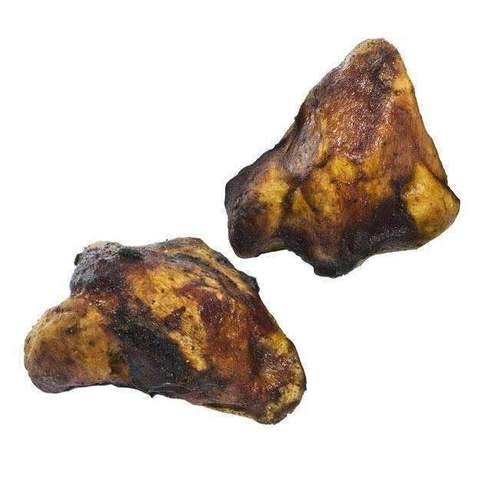
About: These cartilage-heavy bones are typically meaty and intriguing to most dogs thanks to their smoked nature.
They’re larger and sturdier than other beef body parts like bully sticks, and their size is less risky for choking than ears or hooves.
PROS
Because they’re relatively hard and long-lasting, beefy joint bones are ideal for heavy chewers. Taste is usually a high point with pups, and they often feature little bits of tasty meat, helping to keep your doggo engaged.
CONS
The hardness of these joints comes with a risk of tooth fracture. They can also splinter and possibly cut your pupper’s mouth or cause digestive obstructions and perforations if swallowed. Since they’re smoked and meaty, they’re also messy, so you may want to only offer these outdoors.
3. Nylon Chews
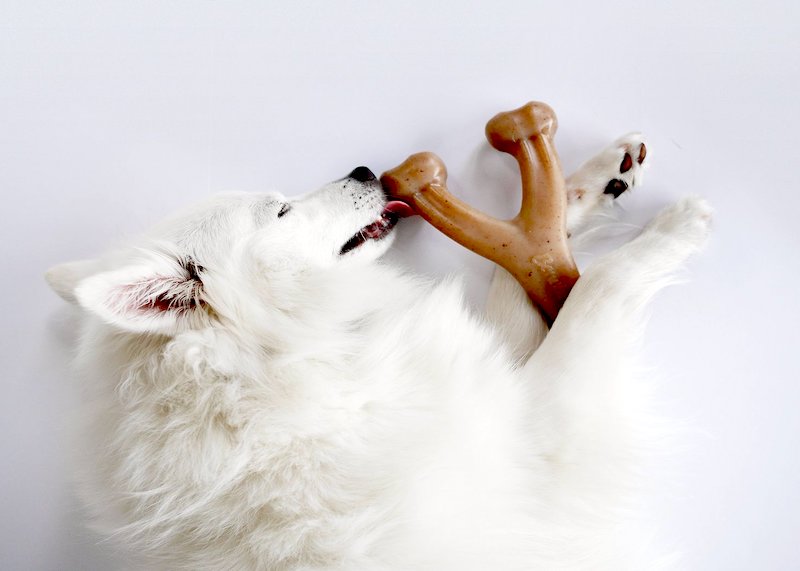
About: Nylon chews like Nylabones and Benebones are crafted into a chew-friendly shape for your pup.
These artificial chews can withstand heavy-duty chewing and added flavoring makes them extra appealing to pups. They also come in many sizes and thicknesses, allowing you to find the best size for your dog’s safety and needs.
We generally consider nylon chews like Benebones and Nylabones safe for most dogs, but due to the hardness of these chews, they can be somewhat controversial, with some dogs breaking their teeth on them.
We recommend grabbing Nylabones or Benebones from Chewy – you can even get 30% off for auto-ship orders!
PROS
Nylon chews are strong and typically last a long time. Because they last so long, they’re more wallet-friendly than short-lived treats like pig ears. They’re easy to wipe clean as needed too, eliminating bacterial growth.
CONS
While nylon bones are long lasting, they are hard, which risks dental cracks if your dog is a mega chomper. These aren’t truly edible, either, and can be split by powerful chewers, which can create dangerous splinters. Some dogs may refuse to chew them too, simply failing to see the appeal of a hunk of plastic.
4. Rawhide
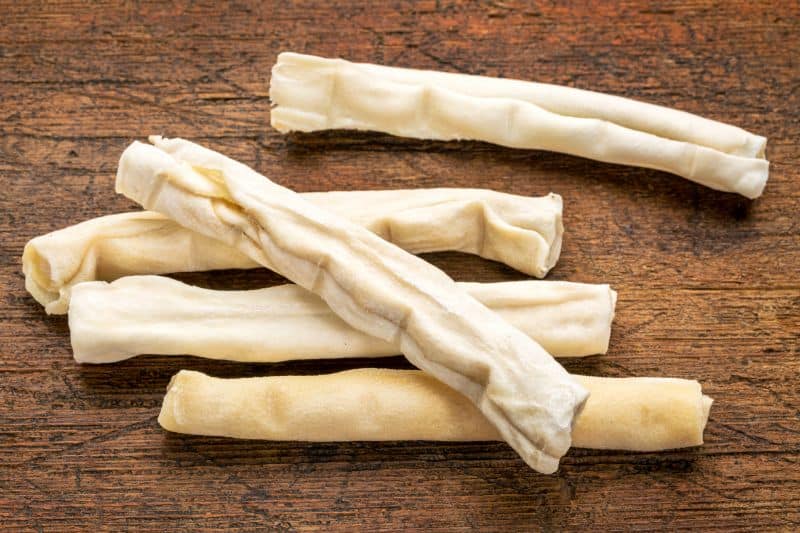
About: Made of untanned cowhide, rawhides are rolled or knotted into a chew-friendly form for your dog.
Rawhide comes in many varieties, with some much harder than others. This makes in-person examination a must to ensure you get the hardness that works best for your pooch.
You should also pay close attention to the country of origin and manufacturing processes used, as rawhides can undergo toxic treatments overseas with deadly chemicals like arsenic used. This can make rawhides especially dangerous when swallowed by dogs.
Since many cheaper rawhide vendors commonly use toxic chemicals when treating rawhide, be sure to opt for a trusted vendor that sells natural rawhide that’s been minimally treated. Pawstruck rawhide is a great choice!
PROS
Rawhides are one of the most affordable dog chews, and they’re easy to find too. Doggos usually love the taste, and the softer material is less of a risk for tooth breakage or mouth injuries. They can be long lasting too, depending on your pup’s chewing habits.
CONS
Rawhide comes with significant risks if ingested. The material may not break down in the stomach and instead expand, causing a painful and potentially deadly obstruction. Choking is another concern, along with cleanliness, as a chewed rawhide’s surface is the perfect breeding ground for bacteria, which can lead to you and/or your pupper getting ill if handled.
Interested in learning more about rawhides or seeing some product recommendations? Check out our rawhide review article!
5. Pig / Cow Ears
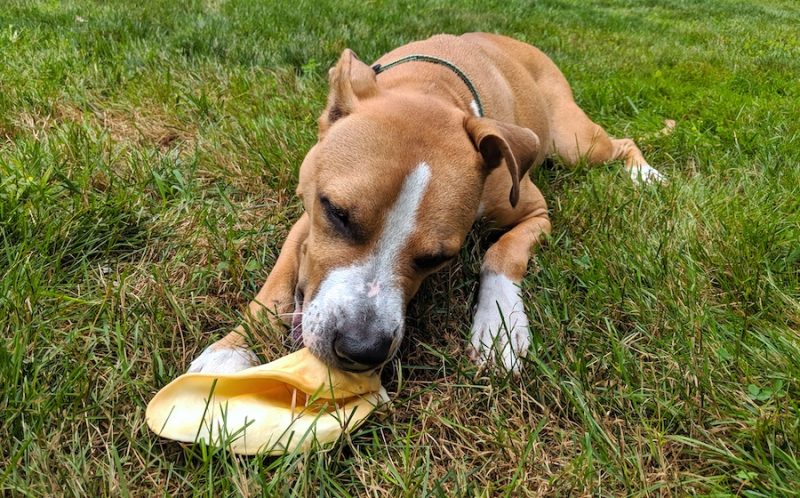
About: Ear chews are some of the most popular dog chews out there with pooches and their parents alike.
Natural and inexpensive, they’re widely available in stores and come in several varieties, including smoked.
Cow ears are larger and typically last longer, while pig ears are smaller, softer, and higher in fat.
Grab quality pig and cow ear chews from Pawstruck!
PROS
Most dogs go gaga over the taste of ear chews. They’re softer than other natural chews and pose less of a risk for tooth or mouth injuries. They can be purchased in bulk too, making them an ideal choice for multi-dog households.
CONS
Aggressive chewers may gnaw right through an ear chew quickly or swallow large pieces, potentially causing choking, stomach upset, or obstruction. Pig ears can be greasy too, adding to the risk of tummy trouble.
Check out our cow ear review article to learn more about these chews and see a few of our favorites. You may also want to consider beef cheek rolls!
6. Collagen Chews
About: Collagen chews are some of the safest chomper treats out there.
Made using protein-rich beef collagen, these tasty chews come in an array of shapes and sizes, letting you pick what works best for your pooch.
They’re hard, but not overly so, making them ideal for most dogs to enjoy without too much of a risk of tooth or mouth injury. They’re best suited for low-to-moderate chewers.
PROS
Collagen is easily broken down in the belly, unlike manufactured compounds or hardened natural products, like hooves and rawhide. In some ways, this makes them less likely to cause an obstruction. These can be flavored too, enticing picky dogs to give them a try.
CONS
Aggressive chewers may wear down a collagen chew quickly, upping the risk of stomach upset if too much is ingested at once. If your dog is a heavy-duty chewer, we’d limit how much he can have at once to keep his tummy happy. Gnawed off bits pose a choking risk, so always keep a close eye on your pooch as he chews his new treat.
Collagen chews catch your eye? Read our hands-on review of Frankly Collagen chews!
7. Dogwood
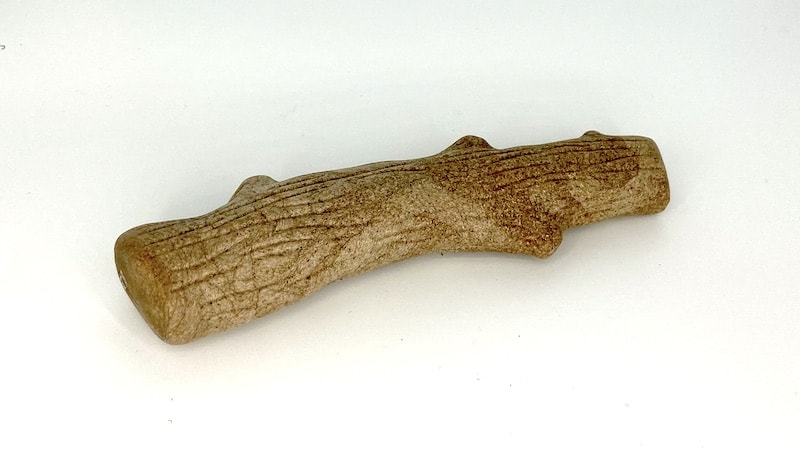
About: Dogwood is a processed material made to mimic the sticks that some doggos can’t get enough of.
Using wood and polypropylene, the chew’s can be used for chewing only or mouth-friendly games of fetch too.
Offered in multiple lengths, they can be purchased for dogs of any size and work best for moderate chewers.
You can order Dogwood sticks on Chewy or Amazon.
PROS
These are a safer alternative for dogs who can’t get enough of chewing sticks in the backyard. They aren’t prone to shattering, either, like some chews. Added flavoring can make them irresistible to most doggies too, even picky pooches.
CONS
Dogwood chews might be too hard for some dogs to enjoy safely. If they’re chewed into a sharp point, they risk painful mouth injuries. Smaller pieces can become choking or obstruction hazards too. These also aren’t natural chews or truly edible, although this rarely seems to cause issues for doggos.
8. Hooves
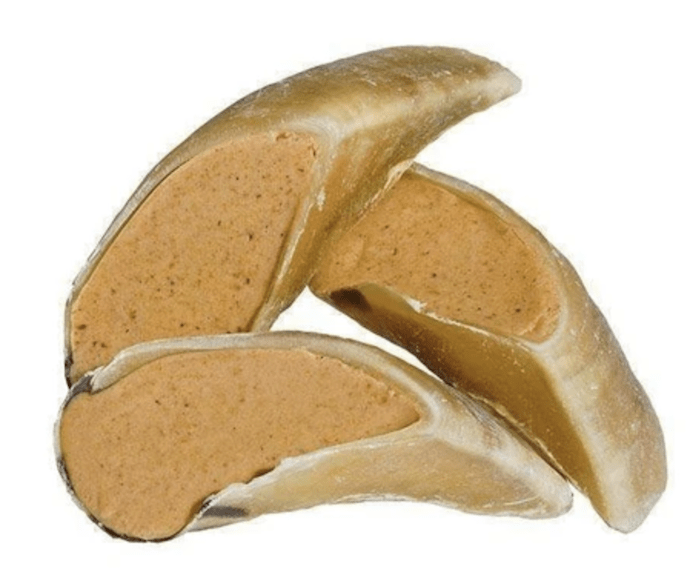
About: Cow hooves are a tough chew durable enough to stand up to powerful jaws, and even aggressive chewers will see these last a bit.
They’re natural too, lacking the heavy treatment seen in other chews, like rawhides.
Grab stuffed cow hooves chews from Pawstruck!
PROS
Hooves are one of the cheapest long-lasting chews available. Dogs also usually enjoy the flavor more than other options. They feature an inner groove that you can load with dog-friendly peanut butter or cheese spread for a fun surprise, too.
CONS
A hoof’s edges can get sharp, risking mouth injuries or tummy trouble if ingested. The tapered shape is easier to break down than other chews, potentially leading to choking or obstruction issues if your dog swallows too large of a piece. The smell can also be off-putting, depending on the variety.
Think these may be a good fit for Fido? We’ve examined cow hooves in depth before.
9. Horns
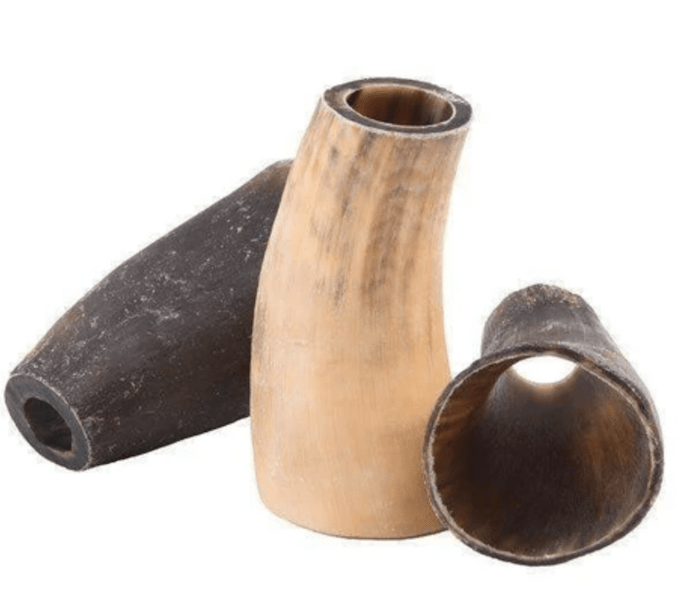
About: Typically coming from a sheep or a water buffalo, horns are tough chews that can weather heavy chewing. You can also stuff them with goodies like peanut butter to keep your doggo interested in them longer.
PROS
Like hooves, horns are relatively inexpensive compared to antlers and other natural chews. Strength is another upside, making them one of the longer-lasting chews available.
CONS
A horn’s hardness risks teeth damage, and the ends can be sharp, putting your pup’s mouth, gums, and tongue at risk for scrapes and punctures. Some dogs may be able to chew off large pieces that can cause choking or obstructions, too. Others may dislike the taste.
10. Bully Sticks
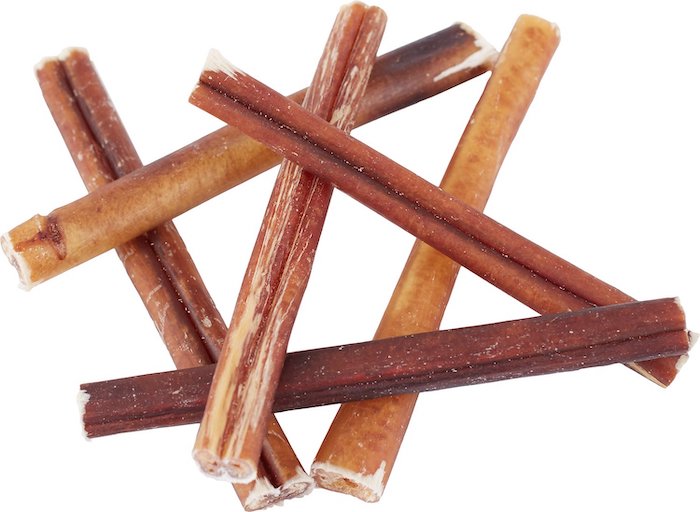
About: Bully sticks are an all-natural chew made of dried bull penis. Another more pleasant name for the penile product is a pizzle.
Offered in single sticks and braided varieties, bully sticks are solid but not as hard or risky for teeth as bones or horns.
Since they’re sourced from a single animal protein, they’re also ideal for puppers with sensitive systems.
PROS
Bully sticks are a good, durable treat for ongoing light to moderate chewing. They’re entirely edible and break down in the belly, making them safer than other chew options. They won’t shatter, either, reducing the risk of mouth injury.
CONS
While tasty, bully sticks aren’t as long-lasting as other chews. Some dogs simply eat them rather than gnaw at them, eliminating potential tooth-cleaning benefits. They can be smelly too, and since they aren’t very durable, it can get expensive replacing them.
We’ve taken a deep dive into these chews in our bully sticks review article. Check it out and see a few of our favorites!
11. Bones
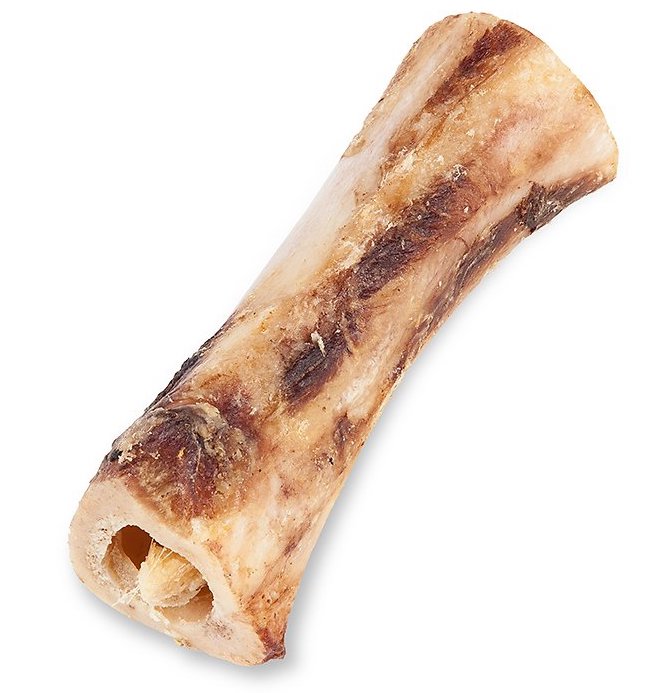
About: Bones are a serious hit and miss area for dog chews. The safest ones are those that are raw as they’re softer and more pliable.
Raw beef bones are the best variety for chewing since they’re larger. Cooked bones are dangerous and should never be given to your pooch.
Cooking breaks bones down and leaves them brittle, risking shattering that will cause serious mouth and internal injuries.
PROS
Raw beef bones are as natural as it comes, and you don’t have to worry about strange additives or food sensitivity issues. Small pieces can be safely chewed off and eaten, which provide minerals for your pupper. They’re relatively cheap, too.
CONS
Bones can crack teeth or injure your dog’s mouth if chewed into a point or splintered. They also come with a risk of choking and stomach obstruction. Raw bones also risk bacterial growth and odor, so always offer them to your pooch outside or in a place that can be easily cleaned. With that in mind, they’re best for onetime use to avoid food-borne illness.
12. Beef Trachea
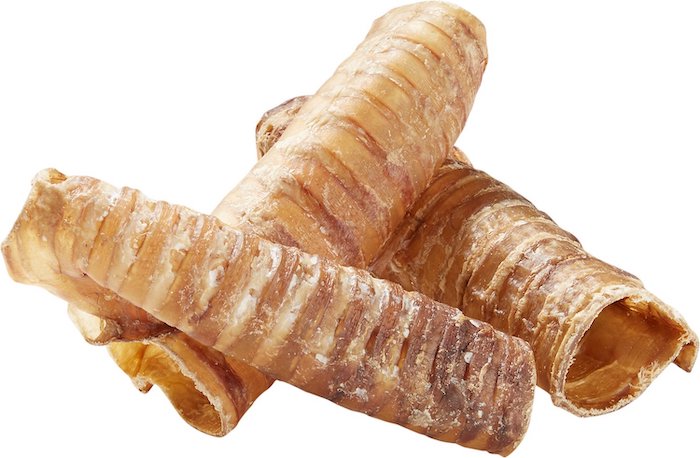
About: Beef trachea is a good option for low-to-moderate chewers. The tube-like shape is easy for most doggos to handle, though the width can be a bit large for small breeds.
For petite pooches, esophagus strips may be a better option.
PROS
Tracheas are a good source of chondroitin and glucosamine, ingredients commonly found in joint supplements. They aren’t as firm as other chews and are less of a risk for tooth damage or mouth injuries. Tracheas are also relatively cheap, leaving plenty of room in the budget for more doggone goodies.
CONS
Not every dog likes the taste of tracheas. They can be smelly and oily too, making them less than ideal for use indoors. They’re also not the hardiest chew and may not last long.
13. Yak Cheese
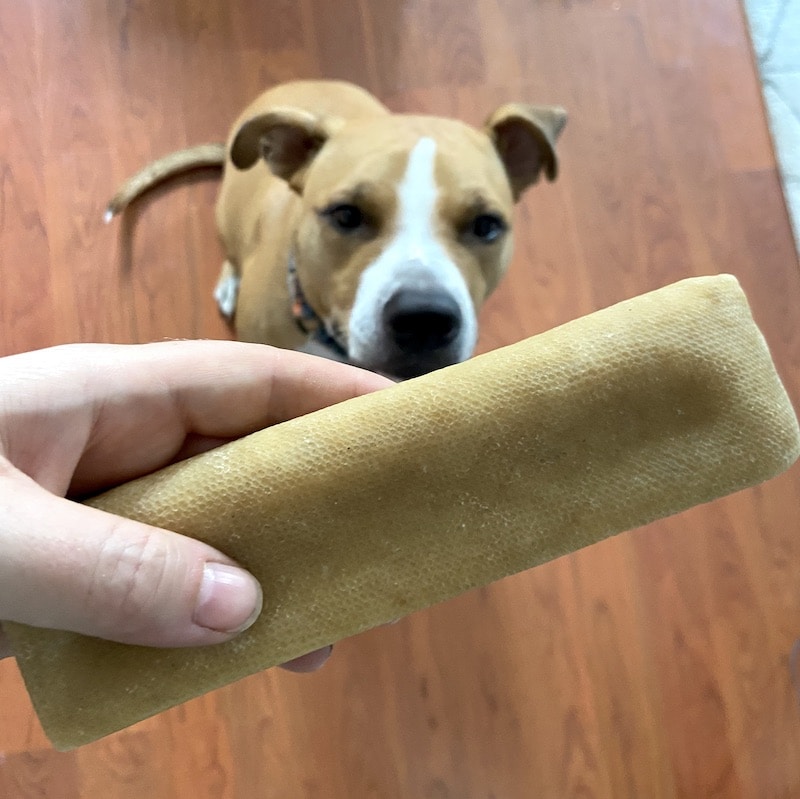
About: Also known as yak chews, yak cheese is a product made by combining yak milk, salt, and lime juice and smoking or drying the mixture over an extended period.
The result is a compressed hunk of hard yak cheese. The formula may also include smoke flavoring or color and is typically low-odor compared to some other chews.
You can order natural yak cheese chews from Chewy!
PROS
Yak cheese is one of the rare manmade chews that is entirely edible. Really big yak chews are often a great option for aggressive chewers, as they are hardy and long lasting. Most dogs enjoy the flavor too.
CONS
Some forms may be too hard and risk damaging your pup’s teeth. Others may be too soft and not last long enough. The product can also be pricey too, with most authentic varieties being imported from the Himalayas. You also want to make sure your dog doesn’t eat too much yak cheese at once to avoid belly issues.
14. Fish Chews
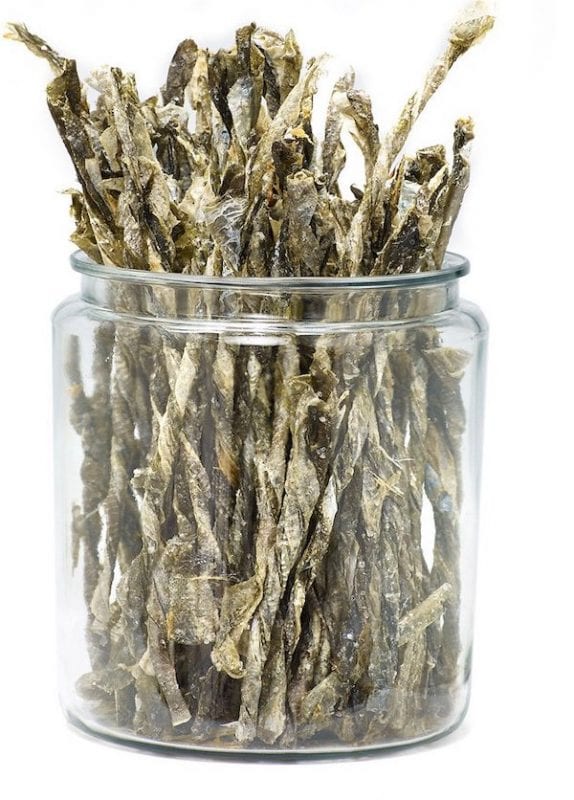
About: Made of dehydrated fish, fish chews are protein-rich treats that are best for light to moderate chewers.
These aren’t as risky for dental or oral injuries, and most dogs go crazy over the taste. Since they’re from a single source, they also are friendly for floofs with sensitive systems.
PROS
Fish chews are softer than other natural chews, making them some of the safest chewing options available, particularly for puppies or older dogs. Since they come in packs, you’ll get a few chew sessions with every purchase, but make sure you don’t give them too often, as they can pack on the pounds if you’re not careful.
CONS
While they are safer than other options, fish chews are not very durable and do not last long. Since they’re fish, they obviously have a fish smell too, which is less than friendly on the nose, so you may want to give these outdoors. We’d also wait a little bit for puppy smooches afterward to avoid a fishy French kiss.
15. Non-Edibles
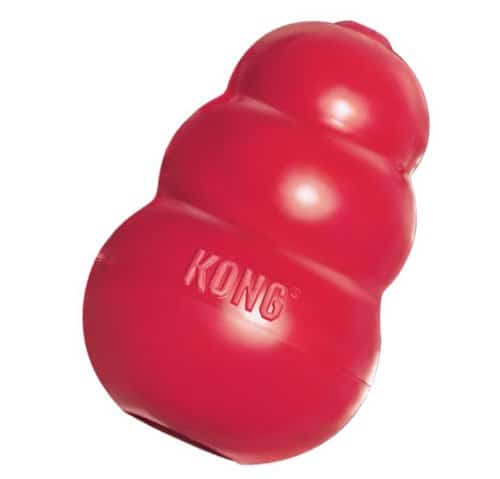
About: Consisting of popular chews like rope toys and KONGs, non-edibles come in varying strengths for you to choose from.
Pricing, size, and shape varies, allowing you to cater the chew to your budget and pupper needs.
These chews are crafted with man-made materials, however, so they’re not the all-natural products that some pup parents seek.
PROS
Ropes can clean teeth and gums as your dog nibbles the strands. Non-edibles like KONGs are also a hit because they can be stuffed with enticing treats like peanut butter, and the brand’s Extreme line is strong enough to withstand heavy chewing without harming your pup’s mouth.
CONS
Since these aren’t truly edible, there’s an inherent risk if ingested. They’re foreign bodies and won’t break down in the stomach like organic materials. Some non-edibles are stronger than others, with ropes especially easily shredded by heavy chewers.
Need more info on non-edible chews that’ll last?
Check out our review of rope toys, or get some ideas about things you can stuff inside a KONG.
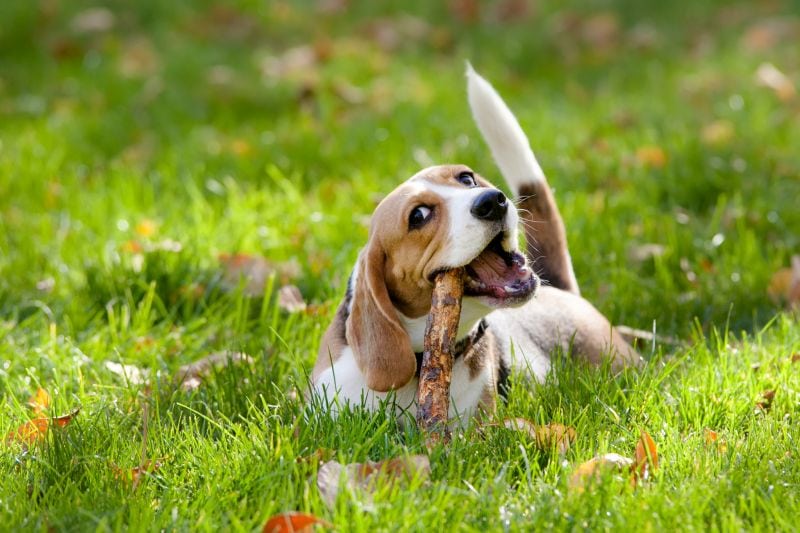
Long-Lasting Dog Chews
Quick Reference Chart
There’s a lot to take in when you start trying to pick the best long-lasting chew for your pooch.
So, we’ve put together the table below so you can see how these chews stack up against each other at a glance.
We briefly describe the pros and cons of each style below, and provide our own overall safety rating. Chews that have a score of 1 are the riskiest options, while those with a 3 are the safest. Those that earn a 2 are somewhere in between the two extremes.
Just remember to monitor your dog closely — even those that we rank the safest can cause problems for some pooches.

***
Have you tried any of these chews with your pup? What chew lasts the longest for your four-footer? Let us know in the comments!
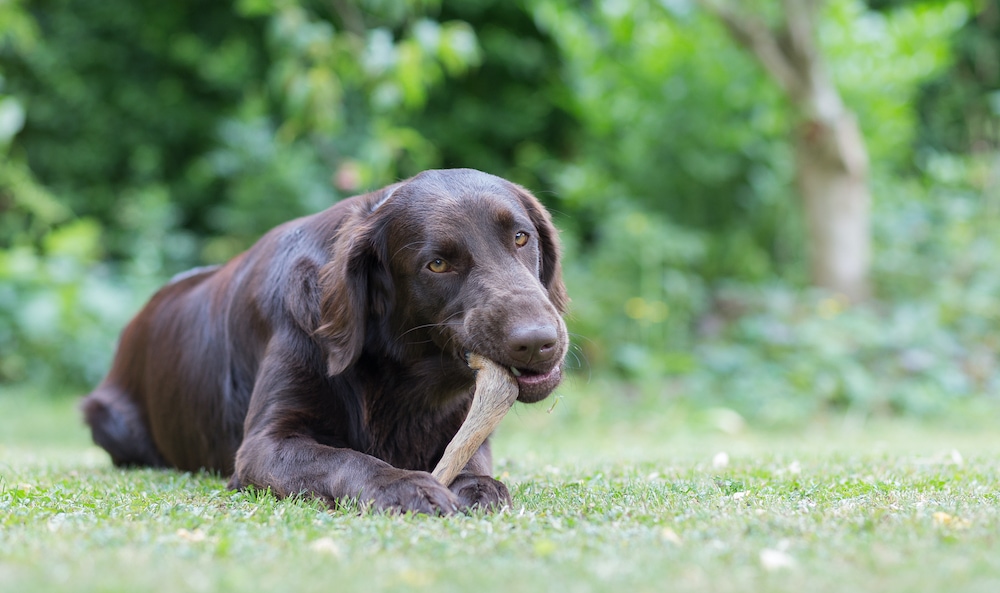

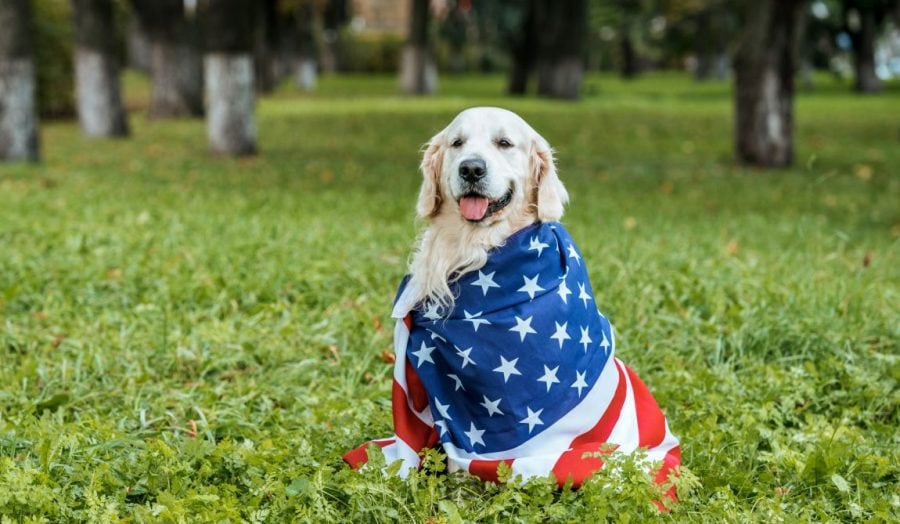


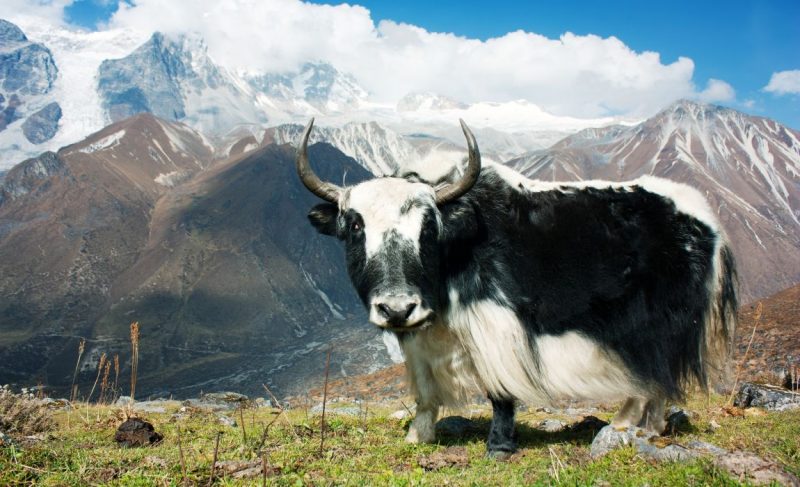
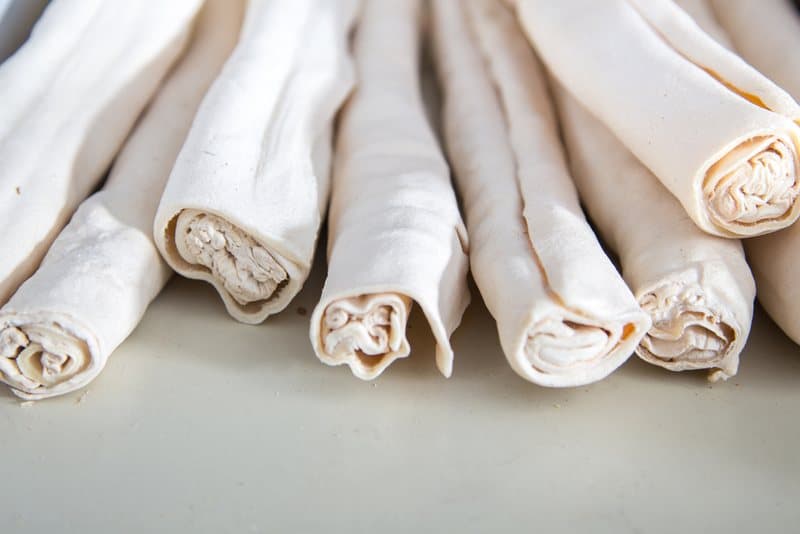
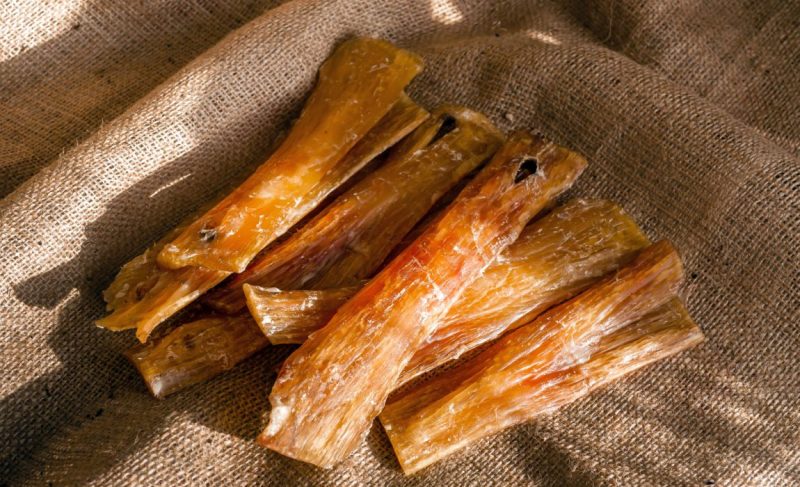
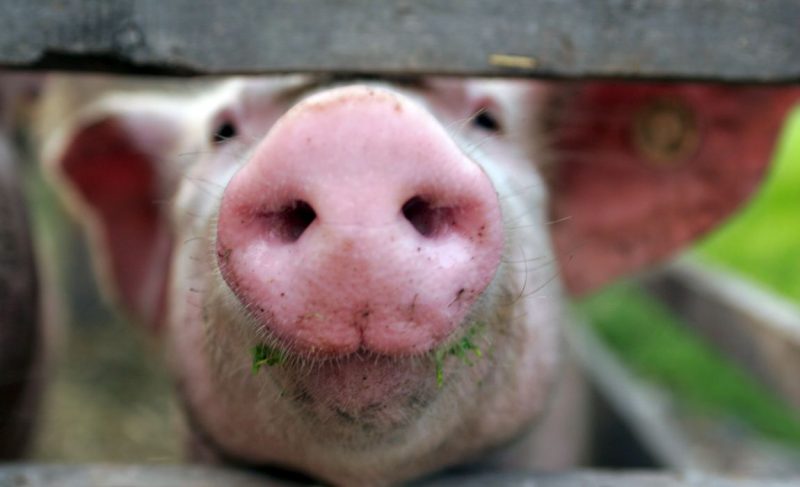
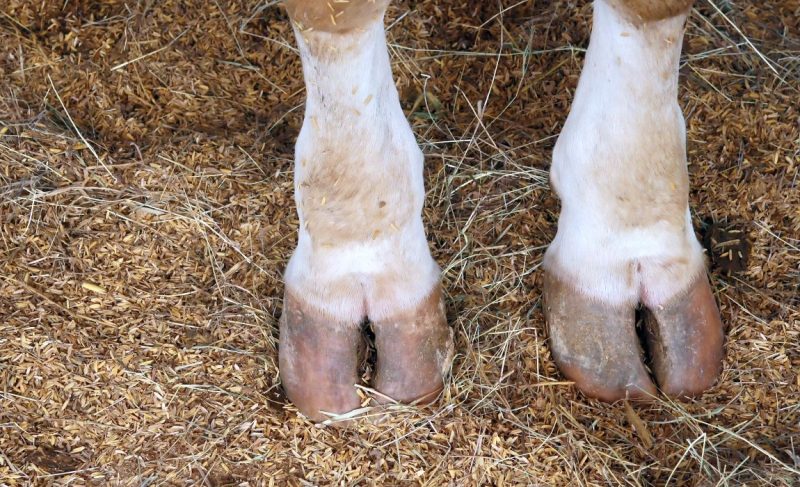
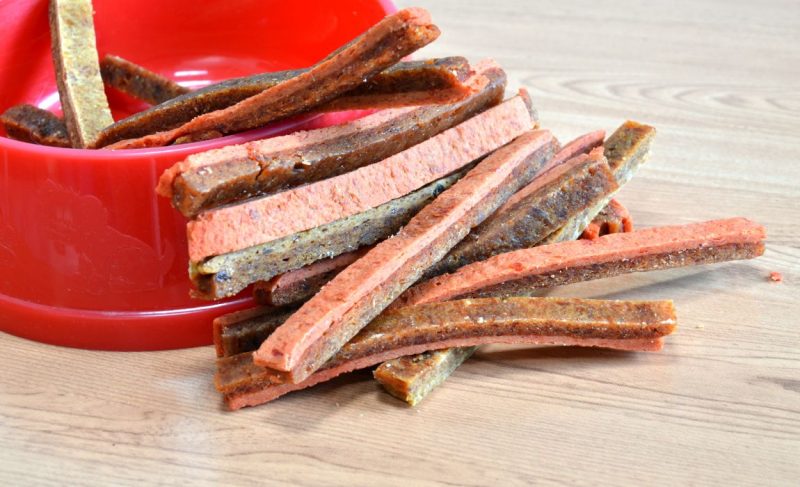

Leave a Comment